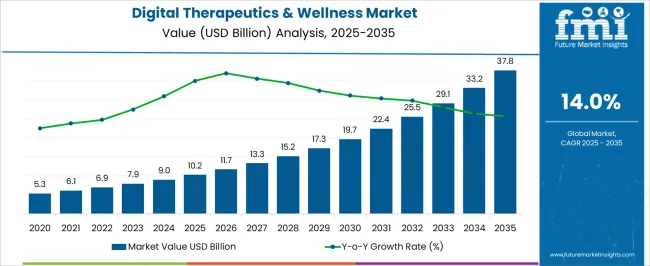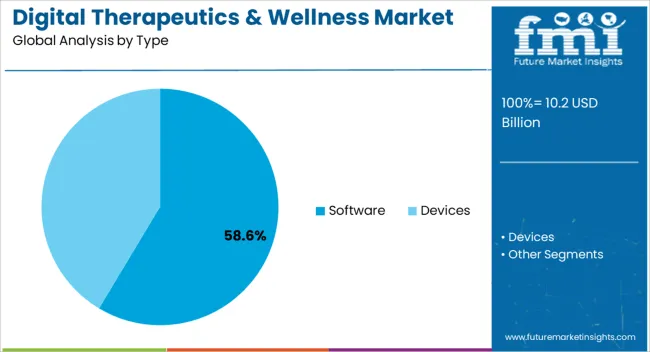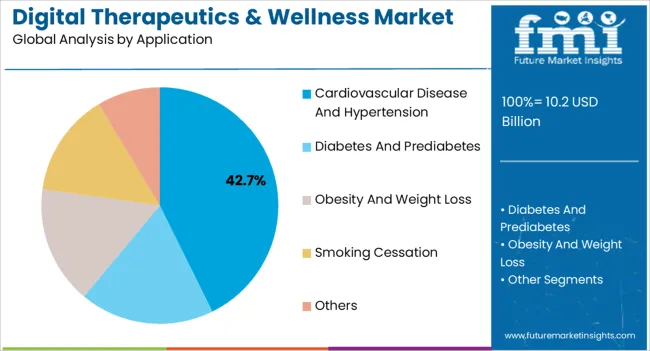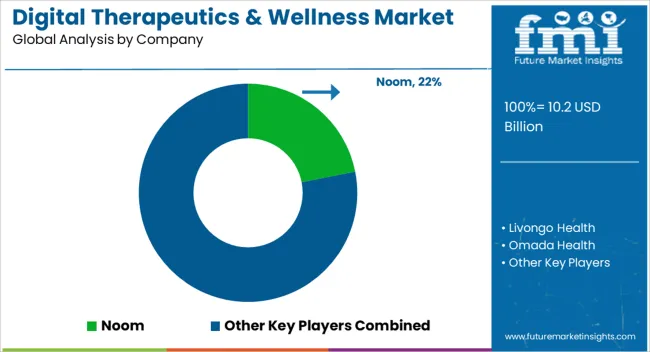The Digital Therapeutics and Wellness Market is estimated to be valued at USD 10.2 billion in 2025 and is projected to reach USD 37.8 billion by 2035, registering a compound annual growth rate (CAGR) of 14.0% over the forecast period.

| Metric | Value |
|---|---|
| Digital Therapeutics and Wellness Market Estimated Value in (2025 E) | USD 10.2 billion |
| Digital Therapeutics and Wellness Market Forecast Value in (2035 F) | USD 37.8 billion |
| Forecast CAGR (2025 to 2035) | 14.0% |
The digital therapeutics and wellness market is expanding rapidly, supported by rising prevalence of chronic diseases, increasing adoption of digital health platforms, and growing patient preference for remote care solutions. Advances in software-driven therapeutic programs have enhanced accessibility, personalization, and scalability of treatment options across diverse healthcare ecosystems.
Integration of AI, machine learning, and real time analytics into digital therapeutic platforms has improved disease management outcomes while reducing healthcare costs. Regulatory approvals and growing payer support are further encouraging adoption across both developed and emerging economies.
With heightened emphasis on preventive care, lifestyle management, and long term patient engagement, the market outlook remains highly positive, offering strong growth potential in the years ahead.

The software segment is projected to represent 58.60% of market revenue by 2025 within the type category, positioning it as the dominant offering. Its leadership is attributed to scalability, ease of integration, and ability to deliver personalized therapeutic interventions at lower costs compared to hardware based alternatives.
The software approach also allows continuous updates, remote monitoring, and real time feedback, all of which improve treatment adherence and outcomes. Growing partnerships between technology firms, healthcare providers, and insurers have further accelerated uptake.
The adaptability of software solutions across multiple devices including smartphones and tablets has broadened accessibility, strengthening its role as the preferred type segment in digital therapeutics and wellness.

The cardiovascular disease and hypertension segment is expected to account for 42.70% of market revenue by 2025 under the application category, making it the leading therapeutic focus. This growth is being driven by the global rise in cardiovascular disorders and hypertension, which remain among the leading causes of morbidity and mortality worldwide.
Digital therapeutics platforms have been increasingly deployed to aid patients in monitoring blood pressure, tracking lifestyle changes, and receiving tailored interventions that support long term disease management. Their ability to improve patient compliance, reduce hospital visits, and provide actionable insights for clinicians has strengthened adoption.
Furthermore, public health initiatives promoting preventive care and patient centric digital health models have reinforced the dominance of cardiovascular disease and hypertension applications in this market.
The key factor expected to propel the growth of the digital therapeutics and wellness market during the forecast period is the increasing smartphone penetration in developed and developing countries.
Other significant reasons such as the cost-effectiveness of digital health technology for providers & patients and increasing demand for integrated healthcare systems & patient-centric care are also expected to boost the market growth over the analysis period. Moreover, a few more vital things that are estimated to contribute significantly toward digital therapeutics and wellness industry growth are:
There are some key reasons that are acting as obstacles and are hindering the market growth during the forecast period.
Some countries, such as the United States (with its Health Insurance Portability and Accountability Act (HIPAA) and the Health Information Technology for Economic and Clinical Health (HITECH) Act), have legislation focusing on the issue of data security. However, despite such federal initiatives, digital therapeutics users are subject to infringement and data breaching, which may restrain the growth of the digital therapeutics market.
Motivating people to use digital therapeutics and building their confidence is another factor that is expected to hamper the growth of the digital therapeutics and wellness industry. Moreover, the rise in concerns related to cyber threats and data security hinders market growth.
According to Kepios, in April 2024, there were 4.27 billion internet users globally, which is over 60% of the global population. As this number increases, awareness about smart health tracking is expected to improve. Furthermore, supportive regulatory initiatives & early signs of reimbursement, and the increasing pervasiveness of chronic disorders are also anticipated to fuel the market growth.
The lack of skilled medical practitioners in developing regions highlights the importance of connected healthcare. Furthermore, developing countries like India and China lack proper standards and government regulations for digital health solutions, which offer huge potential to providers who cannot meet stringent standards set by the federal government in the United States. The patient-doctor ratio in these regions is also significantly high, necessitating alternative healthcare solutions.
China and India are also observing high adoption of smartphones and its associated technologies owing to its increasing affordability. Globally, these countries are the top two countries in terms of smartphone ownership. Furthermore, the increasing access to smart devices and the Internet has encouraged the development of health apps.
Government bodies in China and India are taking initiatives to improve HCIT infrastructure. For instance, in its five-year plan from 2020 to 2024, China aimed to improve healthcare quality by implementing HCIT solutions.
The market observed CAGR of 12.5% in the historical period. In 2025, the market reached market size of USD 6,900.5 million. Over the forecast period, the market is projected to expand at a momentum of 14.6% CAGR. In 2025, the market is projected to achieve USD 7,797.6 million. By 2035, the market is slated to reach USD 30,553.8 million.
Key factors propelling market development of digital therapeutics and wellness industry include:
| Segment | Software |
|---|---|
| Market Share % (2025) | 56.8% |
According to FMI, on the basis of type, software represents a significant CAGR of 13.9% during the forecast period. The segment contributed 56.8% of the overall market share in 2025. The segment growth can be attributed to the increased adoption of advanced software technologies by the healthcare industry.
Based on application, cardiovascular disease and hypertension represent a significant CAGR of 13.4% during the forecast period, owing to the increasing usage of apps based on cardiovascular disease and hypertension. For instance, Japan based CureApp introduced DTx app for hypertension, which reduces heart disease and stroke risks.
| Regions | CAGR |
|---|---|
| North America Market Size (2025) | 29.5% |
| Europe Market Size (2025) | 21.9% |
| The United States Market Size (2025) | 18.6% |
| Germany Market Size (2025) | 9.5% |
| Japan Market Size (2025) | 3.9% |
| Australia Market Size (2025) | 2.9% |
| China Market CAGR % (2025 to 2035) | 13.2% |
| India Market CAGR % (2025 to 2035) | 16.5% |
| The United Kingdom Market CAGR % (2025 to 2035) | 15.1% |
North America accounted for 29.5% of the overall market share in 2025. This regional growth is due to:
High incidence rate of chronic disorders and geriatric population in North America are estimated to propel market development.
The demand for digital therapeutics and wellness in the United States is projected to reach a valuation of USD 37.8 billion by 2035 with a CAGR of 14.1%. Asia Pacific region is expected to expand at a significant growth rate during the projected period. This high growth can be attributed to the increase in demand for effective healthcare, the rise in smartphone penetration, and improved access to the internet.
Growing demand for personal care devices and related services, as a result of increased government spending on healthcare, is another significant factor expected to accelerate market growth.
China is expected to reach a market size of more than USD 1.7 billion in 2035, representing a CAGR of 13.2%, over the forecast period. Japan and the United Kingdom are expected to reach the market size of more than USD 1.4 billion and USD 1.1 billion in 2035, representing growth forecasts of 12.7% and 13.2% respectively, throughout the forecast period.
South Korea, on the other hand, is expected to reach a market size of more than USD 827.8 million in 2035, representing a CAGR of 11.9%, during the forecast period.

Noom, Livongo Health, Omada Health, WellDoc, Pear Therapeutics, Proteus Digital Health, Propeller Health, Akili Interactive Labs, Better Therapeutics, and Happify, among others, are the top companies in the market.
With a substantial digital therapeutics and wellness industry share, these main firms are concentrating on growing their consumer base in new countries. These businesses are making use of strategic collaboration initiatives to grow their market share and profits.
Small and mid-size businesses are conversely enhancing their market presence by penetrating new markets and getting new contracts. All this is facilitated by product innovations and technical developments.
Recent Developments
| Attributes | Details |
|---|---|
| Forecast Period | 2025 to 2035 |
| Historical Data Available for | 2020 to 2025 |
| Market Analysis | USD million for Value |
| Key Countries Covered | The United States, Canada, Germany, the United Kingdom, France, Italy, Spain, Russia, China, Japan, South Korea, India, Thailand, Malaysia, Indonesia, Australia, New Zealand, GCC Countries, Northern Africa, and South Africa |
| Key Segments Covered | Type, Application, and Region |
| Key Companies Profiled | Noom; Livongo Health; Omada Health; WellDoc; Pear Therapeutics; Proteus Digital Health; Propeller Health; Akili Interactive Labs; Better Therapeutics; Happify; Kaia Health; Mango Health; Click Therapeutics; Canary Health |
| Report Coverage | Market Forecast, Company Share Analysis, Competition Intelligence, DROT Analysis, Market Dynamics and Challenges, and Strategic Growth Initiatives |
| Customization & Pricing | Available upon Request |
The global digital therapeutics and wellness market is estimated to be valued at USD 10.2 billion in 2025.
The market size for the digital therapeutics and wellness market is projected to reach USD 37.8 billion by 2035.
The digital therapeutics and wellness market is expected to grow at a 14.0% CAGR between 2025 and 2035.
The key product types in digital therapeutics and wellness market are software and devices.
In terms of application, cardiovascular disease and hypertension segment to command 42.7% share in the digital therapeutics and wellness market in 2025.






Full Research Suite comprises of:
Market outlook & trends analysis
Interviews & case studies
Strategic recommendations
Vendor profiles & capabilities analysis
5-year forecasts
8 regions and 60+ country-level data splits
Market segment data splits
12 months of continuous data updates
DELIVERED AS:
PDF EXCEL ONLINE
Digital X-Ray Equipment Market Size and Share Forecast Outlook 2025 to 2035
Digital Marketing Analytics Industry Analysis in Latin America Forecast Outlook 2025 to 2035
Digital Health Market Forecast and Outlook 2025 to 2035
Digital Pen Market Forecast and Outlook 2025 to 2035
Digital X-ray Market Size and Share Forecast Outlook 2025 to 2035
Digital Elevation Model Market Size and Share Forecast Outlook 2025 to 2035
Digital Pump Controller Market Size and Share Forecast Outlook 2025 to 2035
Digital Textile Printing Market Size and Share Forecast Outlook 2025 to 2035
Digital Printing Paper Market Size and Share Forecast Outlook 2025 to 2035
Digital Battlefield Market Size and Share Forecast Outlook 2025 to 2035
Digital Product Passport Software Market Size and Share Forecast Outlook 2025 to 2035
Digital Lending Platform Market Size and Share Forecast Outlook 2025 to 2035
Digital Shipyard Market Size and Share Forecast Outlook 2025 to 2035
Digital Freight Matching Market Size and Share Forecast Outlook 2025 to 2035
Digital Textile Printer Market Size and Share Forecast Outlook 2025 to 2035
Digital Thermo Anemometer Market Size and Share Forecast Outlook 2025 to 2035
Digital Twins Technologies Market Size and Share Forecast Outlook 2025 to 2035
Digital Signature Market Size and Share Forecast Outlook 2025 to 2035
Digital Map Market Size and Share Forecast Outlook 2025 to 2035
Digital Credential Management Software Market Size and Share Forecast Outlook 2025 to 2035

Thank you!
You will receive an email from our Business Development Manager. Please be sure to check your SPAM/JUNK folder too.
Chat With
MaRIA